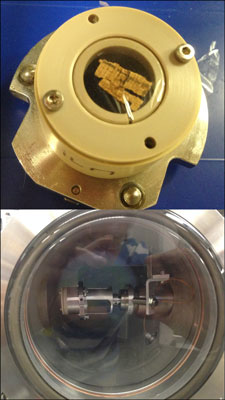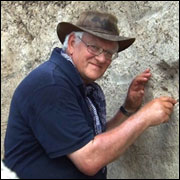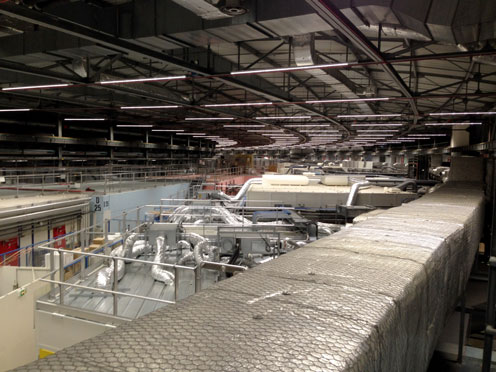Colour technology of ancient egyptian papyrus revealed by synchrotron analysis
The beamline ID21 of the European Synchrotron Radiation Facility (ESRF) in Grenoble has revolutionized our ability for studying the composition of ancient Egyptian ink on papyri. The invention of papyri and ink 5000 years ago was one of the most important discoveries in the history of mankind. It allowed thoughts and technology developed by individuals to be distributed and kept indefinitely changing prehistory into history. The gradual improvement of the Ink is therefore an important cultural heritage worth studying. In the Scientific Reports (Nature) paper published November 10, 2017, copper has for the first time been found to be a constituency of papyrus black ink. The papyri are fabricated over a period of 300 years and geographically spread over the entire Egypt.

The project Ancient Ink as Technology forms part of CoNeXT: Fertilizing the ground and harvesting the full potential of the new neutron and X-ray research infrastructure close to Copenhagen University under the UCPH Excellence Programme for interdisciplinary research across faculty borders with the principal investigators professors Sine Larsen (CI), Kim Ryholt (TORS), and Kell Mortensen (NBI). The Excellence Center supported a PhD student, Thomas Christiansen, in Egyptology, and a consultant in physicsbased archaeology, Poul Erik Lindelof, at the Niels Bohr Institute. Dr. Marine Cotte from ID21 at ESRF and Dr. René Loredo-Portales from the Autonomous University of Mexico were important participants of the research group.
Under the roof of the almost 1 km long circular building of the European Synchrotron Radiation Facility (ESRF) in Grenoble lies the tube conducting the high velocity electrons, which in turn generate the electromagnetic radiation to the more than 100 research beamlines.

The experimental fragments of papyrus with sizes less than 20 mm were chosen in order to fit into the sample holder, which is placed in the collimated synchrotron beam under ultrahigh vacuum conditions. The orientation of the papyrus fragment can be adjusted from outside as seen in the photo below.
The circular building houses a wealth of technical installations, and the beam outlets are focused on samples chosen by experimental researcher coming from all over the World.
The target of the researchers from Copenhagen University are papyri from two old sites at the Nile approximately 600 km distance apart, Pathyris south of Luxor and Tebtunis south of Cairo. These papyri belongs to one of the most celebrated collections, the Papyrus Carlsberg Collection, owned by University of Copenhagen.
Two types of experiments
Two types of experiments were conducted in the synchrotron beamline ID21. One is an X-Ray Flourescence (XRF) scan with an X-ray beam down to subµm cross section. This allows XRF scans with µm resolution in mm area, giving the elemental composition of the ink with pixel sizes, which outperform all other types of XRF experiments by many orders of magnitudes. All the impurities in the black ink on a very fine scale reveals the origin of the ink and its storage conditions.
The most surprising result of the XRF investigation is the similarity of the papyrus ink 600 km apart, separated by 300 years and in one case fragments of private soldier letter and in the other fragments of papyrus found in a temple library. Most strikingly is the content of copper in the black ink in both sets of papyrus fragments. This uniformity points to a much more widespread fabrication technology of ink in the Mediterranean antiquity than previously thought.
The other type of synchrotron studies of papyrus in the just published Scientific Report (Nature) is the so-called XANES (X-ray Absorption Near Edge Spectroscopy) analysis. In the XANES measurements the scattering of X-rays is studied as a function of synchrotron radiation energy at the Bragg edge of the detected impurity copper in the black ink. The shape of the Bragg edge depends on the chemical surroundings of the copper atoms and gives a clue to the molecule with the copper. The article in Scientific Reports reveals copper situated in the molecules of cuprite, azurite and malachite. The implications of this are still to be resolved.
The collaborative research at ESRF on fragments from the Papyrus Carlsberg Collection at the Faculty of Humanity and the Faculty of Natural Science is likely to continue after the cancellation of CoNeXT at the end of 2017. Papyrus and ink was in use in the countries around the Mediterranean Sea for almost 4000 years, and the technology of ink fabrication have so far been almost absent in the scientific literature leaving a scientific vacuum, which can now be filled. The authors of the article in Scientific Reports have almost finished their next experiments at ESRF on red ink on papyrus from Pathyris and Tebtunis.

Kell Mortensen, professor, X-ray and Neutron Science, Niels Bohr Institute, University of Copenhagen, Phone +45 21 51 69 79 Email: kell@nbi.ku.dk
Poul Erik Lindelof, Consultant in Physicsbased Archaeology, Phone: +45 30 28 00 06 Email: lindelof@nbi.ku.dk
Contact
 Kell Mortensen, professor, X-ray and Neutron Science, Niels Bohr Institute, University of Copenhagen, Phone +45 2151 6979 Email: kell@nbi.ku.dk
Kell Mortensen, professor, X-ray and Neutron Science, Niels Bohr Institute, University of Copenhagen, Phone +45 2151 6979 Email: kell@nbi.ku.dk
 Poul Erik Lindelof, Consultant in Physicsbased Archaeology, Phone: +45 3028 0006 Email: lindelof@nbi.ku.dk
Poul Erik Lindelof, Consultant in Physicsbased Archaeology, Phone: +45 3028 0006 Email: lindelof@nbi.ku.dk


